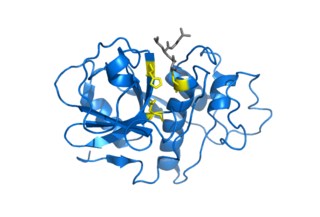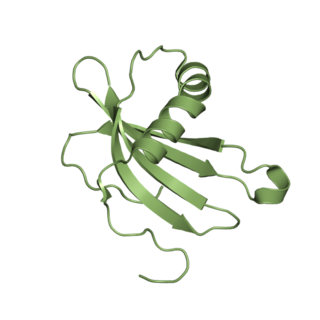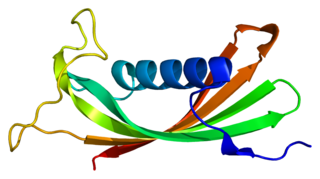
A protease is an enzyme that catalyzes proteolysis, breaking down proteins into smaller polypeptides or single amino acids, and spurring the formation of new protein products. They do this by cleaving the peptide bonds within proteins by hydrolysis, a reaction where water breaks bonds. Proteases are involved in numerous biological pathways, including digestion of ingested proteins, protein catabolism, and cell signaling.

A metalloproteinase, or metalloprotease, is any protease enzyme whose catalytic mechanism involves a metal. An example is ADAM12 which plays a significant role in the fusion of muscle cells during embryo development, in a process known as myogenesis.

Cysteine proteases, also known as thiol proteases, are hydrolase enzymes that degrade proteins. These proteases share a common catalytic mechanism that involves a nucleophilic cysteine thiol in a catalytic triad or dyad.

Cathepsin S is a protein that in humans is encoded by the CTSS gene. Transcript variants utilizing alternative polyadenylation signals exist for this gene.
Kininogens are precursor proteins for kinins, biologically active polypeptides involved in blood coagulation, vasodilation, smooth muscle contraction, inflammatory regulation, and the regulation of the cardiovascular and renal systems.

Cathepsin B belongs to a family of lysosomal cysteine proteases known as the cysteine cathepsins and plays an important role in intracellular proteolysis. In humans, cathepsin B is encoded by the CTSB gene. Cathepsin B is upregulated in certain cancers, in pre-malignant lesions, and in various other pathological conditions.

Cathepsin L1 is a protein that in humans is encoded by the CTSL1 gene. The protein is a cysteine cathepsin, a lysosomal cysteine protease that plays a major role in intracellular protein catabolism.

Cystatin-A is a protein that in humans is encoded by the CSTA gene.

Cystatin-B is a protein that in humans is encoded by the CSTB gene.

Cathepsin H is a protein that in humans is encoded by the CTSH gene.

Cystatin-S is a protein that in humans is encoded by the CST4 gene.

Cystatin-SN is a protein that in humans is encoded by the CST1 gene.

Cystatin-SA is a protein that in humans is encoded by the CST2 gene.

Cystatin-M is a protein that in humans is encoded by the CST6 gene.

Cystatin-F is a protein that in humans is encoded by the CST7 gene.

Cystatin-D is a protein that in humans is encoded by the CST5 gene.

Cystatin-8 is a protein that in humans is encoded by the CST8 gene.

Cystatin-9-like is a protein that in humans is encoded by the CST9L gene.

Cystatin-11 is a protein that in humans is encoded by the CST11 gene.

Papain-like proteases are a large protein family of cysteine protease enzymes that share structural and enzymatic properties with the group's namesake member, papain. They are found in all domains of life. In animals, the group is often known as cysteine cathepsins or, in older literature, lysosomal peptidases. In the MEROPS protease enzyme classification system, papain-like proteases form Clan CA. Papain-like proteases share a common catalytic dyad active site featuring a cysteine amino acid residue that acts as a nucleophile.














